Bella Barista are Official distributors in the UK for Lelit and stock the Lelit Bianca a stunning looking dual boiler machine with an excellent finish and manual pressure/flow profiling capability. Although heat exchanger machines give mechanical simplicity, a dual boiler gives control and temperature stability. It’s major features are:
- A full sized professional E61 group
- Highly accurate dual loop PID Temperature control
- Good sized 1.5 litre service boiler and 800ml brew boiler
- A unique paddle system on the top of the E61 group for controlling water flow and hence pressure seen by the coffee.
- A movable and removable water tank system holding 2.5 litres
- Super quiet rotary pump
The advantage of a separate service (steam and hot water) boiler that may be switched off if not being used saves energy and increases the longevity of internal components because there is less internal heat.
The Lelit Bianca is an Italian built quality machine using mainly industry standard components and traditional construction. This ensures spares availability, so they can be repaired and maintained for decades to come, unlike normal kitchen appliances these machines last a very long time. Something I like very much about Lelit, they often come from left field with their ideas and they are innovative, their machines can have some unusual features. Sometimes I think…“you really didn’t need to do that, but in a way I am glad you did”. Other times I look inside and think “only an engineer would appreciate why they did this”. At times I even think, “that’s a bit mad…but in an interesting way”. I love companies that think outside the box and enjoy working with them to drive genuine improvements. I suspect they don’t always like me too much because I don’t suffer fools gladly and can be very critical when I think something is wrong. Lelit have responded to this far better than most companies, which makes me think they must actually be interested in getting it right as well as making some coin.
This review gives you my take on things, it’s not an advertorial or full of marketing fluff. It is what I think based on more than a decade of experience. If you want to see the Lelit view of their own machine and of course the specifications go to the link below, but be sure to come back here after:
I hope you enjoyed that, I especially liked the comment
“If you are not a real Barista, keep away from me”
In a way it’s misleading, you might think…whoa, this machines a bit difficult for me, I am not advanced enough….perhaps even unworthy of such a machine, or you just think you are not a “Barista”. Don’t worry, it’s as easy to use as any other dual boiler machine, just use it in an uncomplicated way (easy mode). As your knowledge and experience grows, the machine can grow with you. There are many complicated ways to use this machine and the experimentation is fun, instructive and tasty. DO NOT let any concerns about your ability make you believe this machine is too advanced for you, it’s really easy to use!
Another important consideration is just how much money this is but I’d like you to think about it this way and I speak from experience. If your the sort of person who wants the best and is prepared to pay for it, anything you buy for £1000 ish you will probably want to upgrade within a year or so. It’s probably cheaper and easier just to stretch to this and avoid upgrading for decades, if ever!
Overview
It’s always difficult to know where to start with a (long) review, so it’s best I start right at the beginning and then we trudge through it to the end. Many months ago I got a prototype, it was good but not perfect (I guess nothing ever is). I gave Lelit some feedback about essential and desirable improvements. To their credit they took almost everything on board and did all the critical stuff. To give one example, the prototype machine was noisy at times and vibrated badly. This was corrected by Lelit and they must have taken it very seriously because I can confidently say they must have one of the Quietest rotary pump machines on the market, if not the quietest and I have used some quiet ones. A bold claim but wait until you don’t hear it in the videos. It was refreshing to get the chance to have some influence on the Bianca design before launch.
The experience of receiving the production machine and opening the box, is usually an absolute pain for me. Reaching into a deep box and attempting to extract a really heavy (trust me the Bianca is really heavy) espresso machine from a tight fitting box…it’s not much fun. Especially when you are an old, jaded reviewer who sighs heavily at the thought of extracting yet another heavy (smooth and slippery) object from a deep box. The first photo shows the Lelit packaging extracted from the larger extra Bella Barista over box. Now that really was a pain lifting the Lelit box out of that extra protective over box, because I have to keep it all intact! The second photo shows the straps cut, the top wooden support removed and the top flaps cut open. The accessories box is removed (you can see part of it in the background) then you see the Bianca inside.
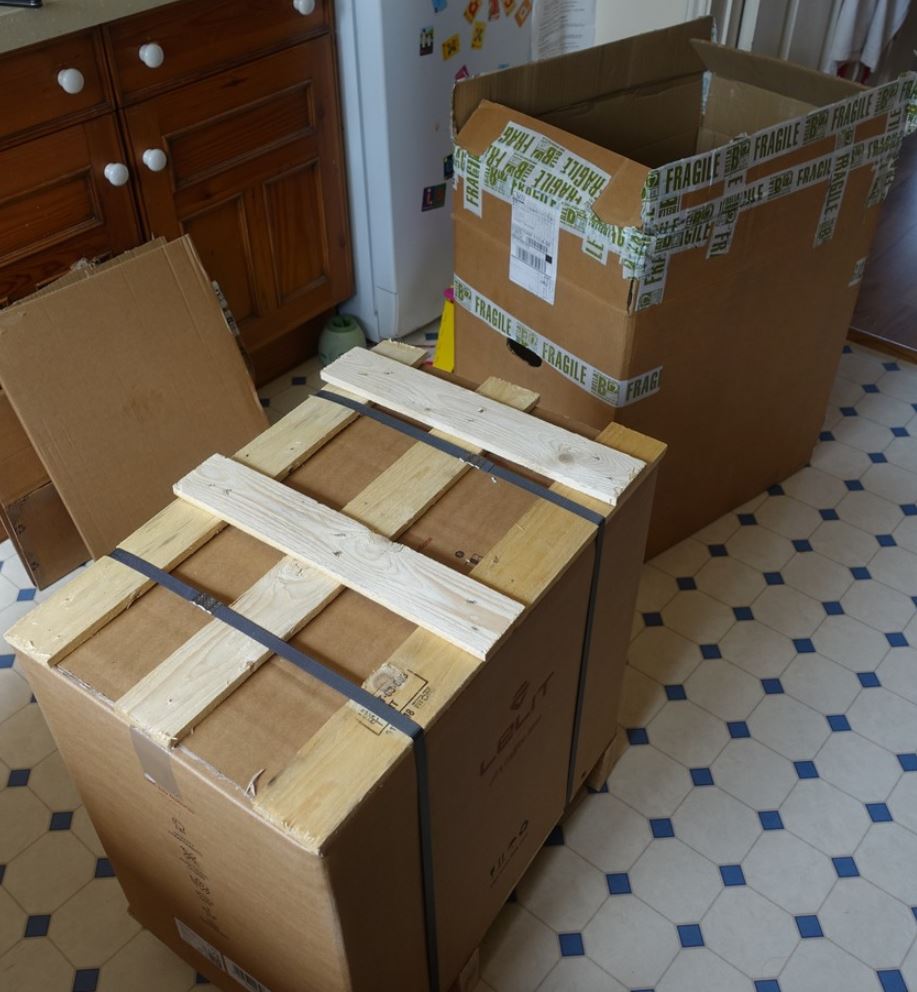
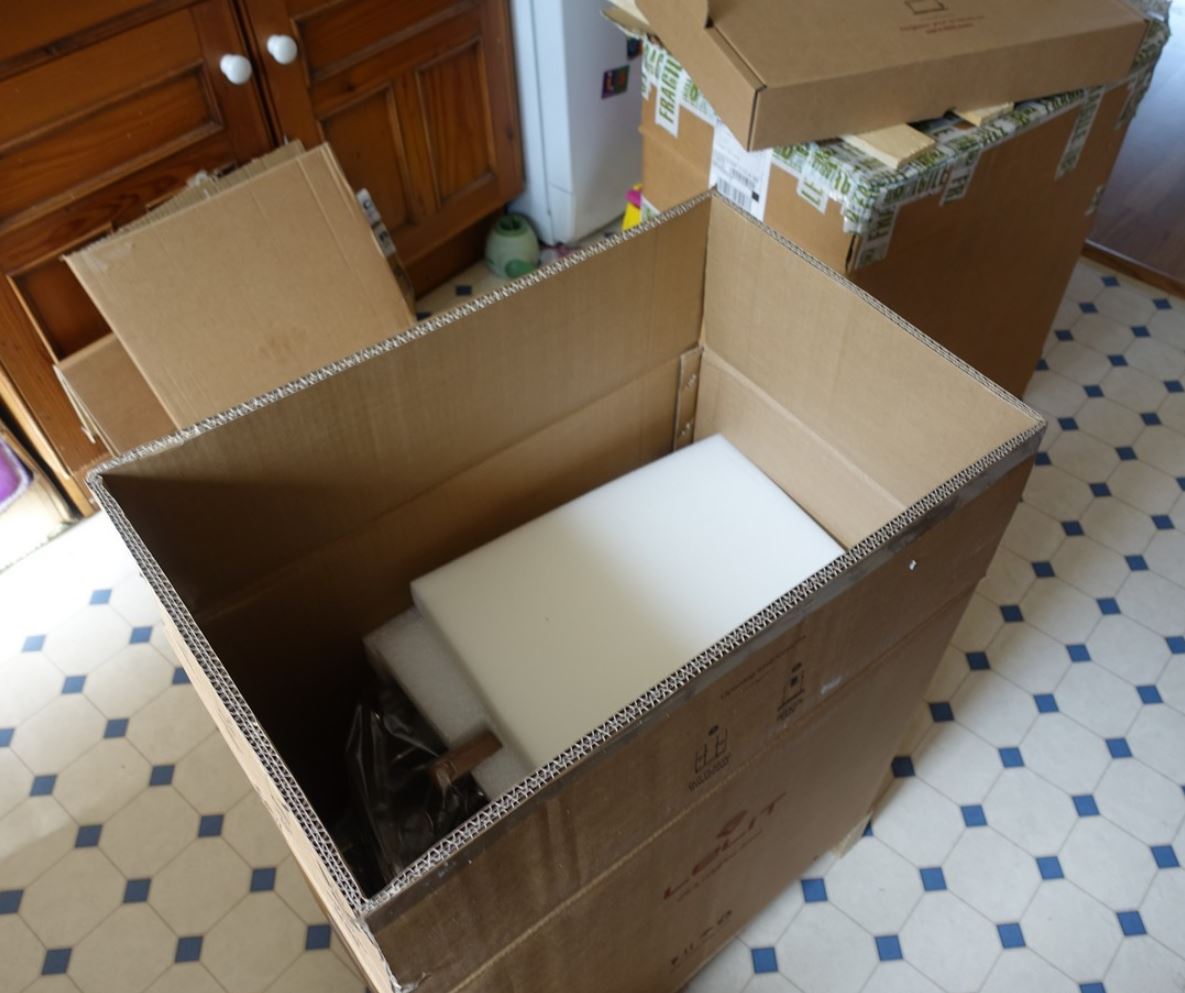
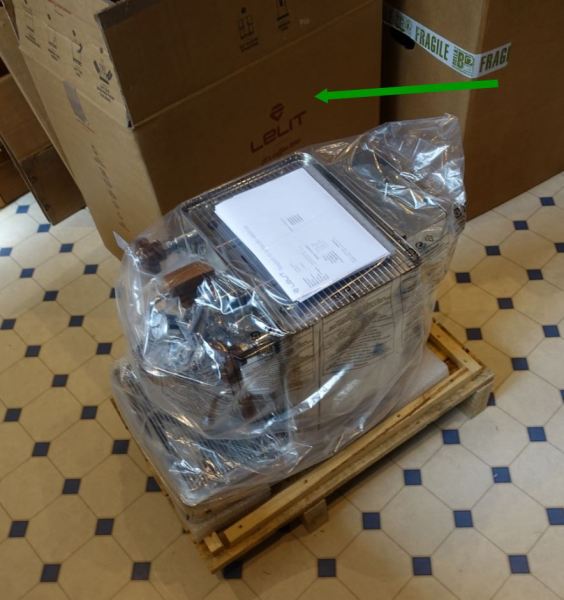
Next the easy bit, remove some staples at the bottom securing the cardboard to the wood and lift it off. You can see it behind the pallet indicated by the green arrow. Now you can easily get your hands on the machine.
I like the packaging system (to a point), but I have strongly advised Lelit review it to prevent any horizontal movement of the machine during extreme rough handling. Of course we all know couriers are really gentle with our valuable shipments, but you know…just in case.
My review machine arrived damaged because the machine had moved inside the Lelit box. Movement is bad because it can partly ride up over the frame on the base, this makes a perfect situation for bending from further impacts. You can see how the front of the machine has ridden up over the internal frame in the photo above.
Lelit have had the packaging designed by a specialist packing company, so were understandably sceptical of my (non specialist) assessment. I have put it in the review because I think it needs revision and as soon as the packaging changes I will come back and update the review. Lelit are currently working with Bella Barista (who have been advised of the problem) to improve the packaging and prevent damage of machines during delivery.
How does it fit in a Kitchen?
The photos show it under normal height kitchen cupboards and it’s positively swallowed up in the corner. It should fit any sized kitchen. It is surprisingly heavy though and I would advise sticking felt furniture pads (as used for wooden floors) on the feet. This will make it much easier to slide around on the counter


A Tour ( inside and out)
The best place to start is the outside of the machine. Normally I launch into an internal technical tour, but I have realise that often people step up to a top end machine as the first machine they buy. What may be obvious to me, so obvious I never bother mentioning it, may be of interest to others.
Oh just in case the future E61 references are confusing, it’s this bit.
A typical E61 group with lever action below:

The E61 is easily recognisable by it’s shape and the fact it is operated by a lever. It weighs around 8 lbs or 3.6 kg and it’s this weight that significantly contributes to brew temperature stability. Being all mechanical, there is little to go wrong and it can be fully internally refurbished (after 10 or 15 years) at minimal cost. It remains one of the most practical, durable, best performing and reliable groups for the home user, working extremely well on HX or Dual boiler machines. It’s beauty to the engineer and consumer alike comes from pure elegance of design, mechanical simplicity and excellent performance.
Exterior and controls
Of course a beautiful exterior means little to me unless it’s beautiful on the inside as well. I will try and keep it as non technical as possible. Today I find many things are marketed with slick advertising rather than substance. If you don’t care what’s inside (I think you really should) then skipping this is OK, I just felt I had to take the trouble to make this. If you want to understand where your money is going, grab some popcorn and a coffee and settle in (it’s a long video).
Inside the Lelit Bianca
You will hear mention of a thermosyphon in the Video. This refers to the circulation of water from the brew boiler into the E61 group and back. This is what keeps the E61 group hot and is an important part of the way the machine works.
Hopefully you found the video interesting and it demonstrates many of the things I like about the Lelit Bianca. In case you didn’t see it, or couldn’t bear to watch it all, Lelit have a great quality interior, some left field thinking which I like and an attention to detail all too often lacking in espresso machine manufacture.
Features,Accessories & Attention to detail
This is a photo of the E61 group taken from underneath…the prototype just had a cheaper standard shower screen on it. They even took the trouble to logo and number the shower screen. I don’t know who is stranger, the sort of person who routinely photographs the underside of shower screens, or the person who wanted a logo on it?

Ridiculous and great all at once that the Lelit design group were dedicated enough to do this! I notice these things though and I appreciate the fact that Lelit have an eye for detail, I thought it was one person who might be very slightly OCD, I am amazed to find out it’s the whole team!
- The brew circuit de-pressurisation solenoid so the gauge drops completely to zero
- The latching steel illuminated on/off switch so a WERMO or mains timer could be used
- The moveable water tank
- The strange but great design for the tank water filter
- The word front on the inner plastic water tank
- Chose the beautiful coffee slide portafilter
- Wanted a pressure gauge on the group
- Probably thought up the needle valve and paddle idea for the E61 group
Even the tank has little counters for the number of times you have filled it since you changed the filter, mad and great at the same time. You are meant to move it 1 mark each time you fill the tank. I am sure no one will actually use the counters…but someone at Lelit “cared” enough to put them there! there are divisions 1-14 on the left handle and 15-28 on the right, each division being worth 2.5 litres. This is because Lelit make 35 litre and 70 litre filters. Now I would bet money on the fact that the OCD types wanted to put the values in litres, not number of fills and was overruled by less OCD types. There are so many other little things I noticed and there just isn’t space to go into them all.
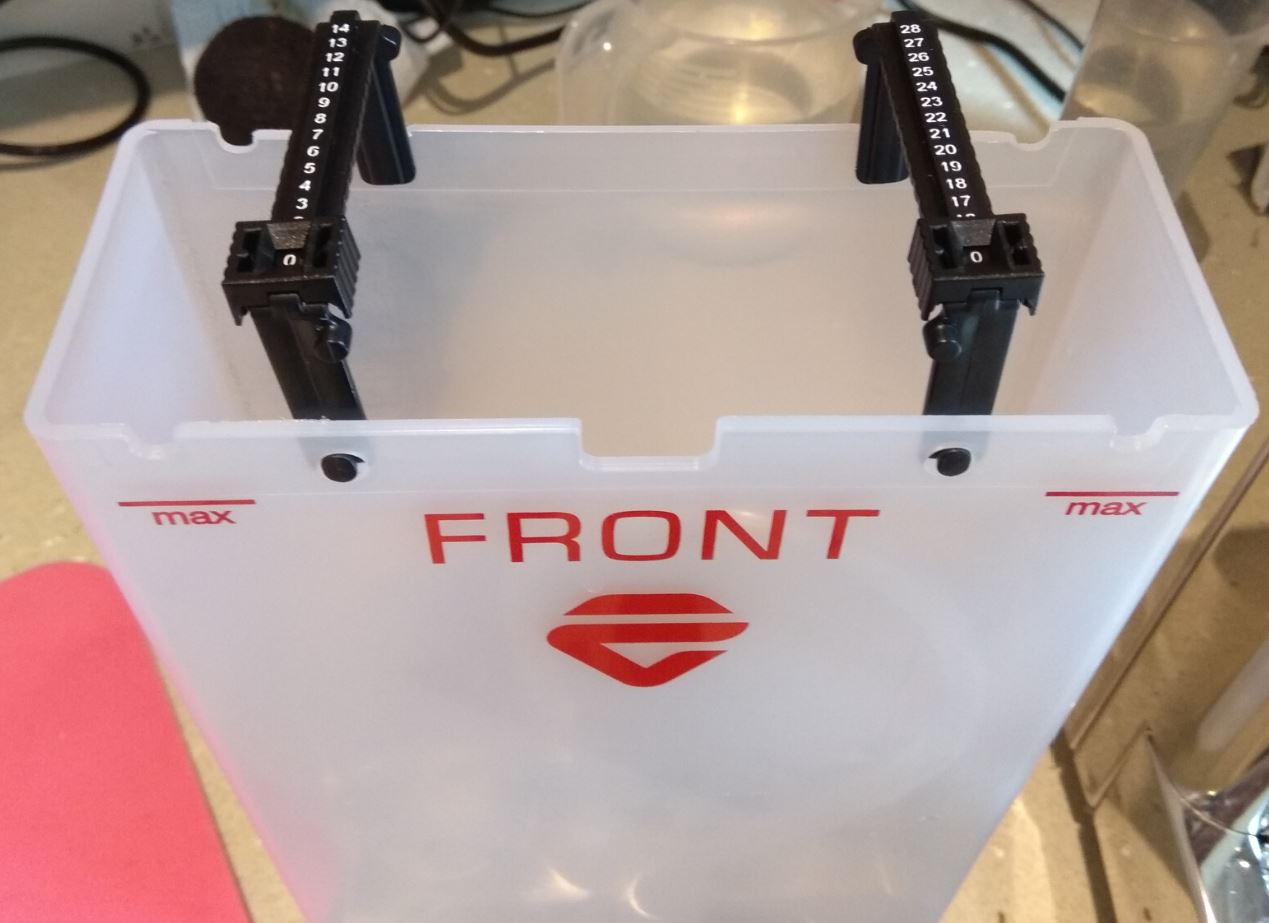
A little message to the OCD team in Lelit…I spotted all the little things you did and I appreciate it, even if other people never see them all!
We need people like this in espresso machine design
I especially like the attention to small details that many manufacturers overlook!
It shows a good understanding of espresso machine design and also that the manufacturer cares about producing a good machine and isn’t frightened to be “different”.
- The extra solenoid valve was actually just to reset the brew pressure to 0 on the pressure gauge. First manufacturer I have ever seen bother to do this, the others simply leave it to gradually come down or sit at 6 bar for a few hours.
- 2 limit stats on the service boiler (becoming more common)
- Nicely implemented PID Control and display system (aesthetically very pleasing)
- Bothering to put a dual pressure gauge on the machine
- Ensuring there is an access port below the boilers, so boiler removal is not necessary to change a heating element (you should use an anti torque strap of course).
- Routing any venting of the safety pressure valve away from the inside of the machine. Many manufacturers are happy for them to blow their guts inside the machine saturating it with steam and boiling water (fortunately this is becoming less common).
- Although a pain to remove, plenty of case screws to ensure the case is very secure)
- Using a rather nice low water system float that is unlikely to give false reading
- Placement of the pump in a very accessible place for pressure adjustment
- The use of a good quality latching power switch on the front of the machine. The modern trend for “soft” switches often prevents the use of Timers or more sophisticated “Wemo” type devices
- Good quality AISI 316L stainless steel boilers, nice and thick end plates and walls (8mm and 1,5mm respectively)
- Good sized boilers a nice 800ml brew boiler and 1.5l steam boiler. These are ideal sizes and smaller boilers give certain technical challenges for steaming and brew temperature stability.
- The rather unusual, but appreciated “start up sequence”, whenever you commission the machine or reset the Gicar….you will see what I mean.
All of these things you often don’t notice as a customer/owner, in fact you probably would never be aware of them. As a reviewer and tester, when I open these machines up, this is the stuff that it’s really good to see. It means they know what they’re doing and they care about doing it well.
Key features customers will notice.
I have identified many premium and unusual features on the Bianca, remarkable considering it’s value proposition:
- Beautifully finished case. Curves in all the right places
- Super quiet rotary pump (premium feature)
- No compression steam and water valves (premium feature)
- No burn ball-joint steam and water wands, with additional slower steam tip (premium feature)
- Dual pressure gauge showing steam and brew pressure (premium feature)
- All metal drip tray of decent size
- E61 group high enough to allow a mug with double portafilter installed
- Great quality PID system from Gicar, programmed for preinfusion, standby, steam on/off, proper dual loop PID, shot timer and other functions (premium feature)
- Separate water tank attached to either side, or rear, or completely removable for plumbed operation. Great for difficult locations and the added benefit of the water keeping much cooler than machines with an integrated tank. (Unique feature)
- Visible low water alarm (no audible sound though)
- Paddle for real time control of flow/pressure within the E61 group (unique feature)
- Pressure gauge on group front port for accurate measurement of pressure seen by coffee puck, this enables (in fact is essential) good control of pressure on coffee when using a flow control system.
- Walnut accents on steam knobs, portafilter handle paddle and E61 group lever (premium feature).
- Unique portafilter spout design they call a “Coffee Slide”.
- Great set of accessories and good quality too.
Overall this is a really nice machine and there are quality features at a very good value for money price. It’s almost 10% cheaper than standard dual boiler machines, but I believe has 30% more value.
What’s supplied with the machine
The accessories box is a joy when you open it…. my initial tongue in cheek thought was, someone wanted to produce it as an oiled walnut box, but calmer heads in Lelit insisted on using cardboard.

I did remove the mains cable because I don’t count that as an accessory. The bits that come with the Bianca are:
- Double (which also works as a single) portafilter with single basket
- Raised espresso cup stand
- Plastic measuring scoop
- Metal Blind filter (for back-flushing)
- Very nice quality polished tamper
- Double portafilter basket (18g, but will hold 19g)
- Double portafilter basket (20g, but will hold 21g)
- Bottomless (or Naked) portafilter, you can use the single or double in this.
- Extra small hole steam tip – I felt an extra tip with smaller holes might help people who prefer slower steaming. The large hole tip comes fitted to the machine
- Water filter (I have boiler safe water so didn’t need to fit it).
- High pressure mains hose for plumbed in operation
- Drain hose, optionally can fit this to the drip tray outlet for full plumbed operation (this means the drip tray does not have to be removed to empty) e.g. running in a small cafe, or commercial establishment.
- An e cloth for polishing your pride and joy.
It’s a formidable assortment and I must say the double spouted portafilter (which also works to make single shots…”just”) is a thing of beauty, it’s called the “coffee slide”. I have never seen one like it before. not even in the Italian trade catalogues for espresso manufacturers stuff. The portafilters are superb quality, really nice.
The User guide is reasonably comprehensive and there are Videos (usage and technical) available on the Lelit website.
The only things left for you to buy is:
- Machine cleaner so it stays shiny, I use Method Stainless steel cleaner, because it’s effective and more importantly non abrasive. Whatever cleaner you prefer just make sure it is totally non abrasive (generally creams are abrasive) and that you use a good quality Microfibre cloth with the label ripped out.
- A set of scales
- A really good grinder, flow profiling machines need a very good grinder to get the best from them
- Very good quality freshly roasted coffee
- Something Like Puly Cafe to keep those parts in contact with the coffee clean. e.g. when backflushing.
- Some nice cups, especially where the single will fit that double spout.
The mains lead separates from the machine like a kettle lead, I really like this and I see more and more manufacturers moving to this rather than fixed leads. I do personally think fixed leads (hard wired) are from the bad old days and would prefer to see them gone completely. Unfortunately the mains lead I got was a Euro plug and I suspect yours will be too. Bella Barista supply (for free) approved plug converters with their machines. Personally I would prefer to see Lelit provide the machines with a UK plug….Lelit, I hope you are reading this.
Performance
Why dual boiler?
Dual boiler machines have some big advantages over their cheaper (older technology) heat exchanger (HX) counterparts. Two boilers separate brewing and steaming. With a Dual boiler system, the brew boiler is heated to any temperature you set to get exactly the right temperature for creating espresso. Important because different beans (or roast levels) can require different extraction temperatures. e.g. you might find one coffee extracts better at 93C, another is tastier at 94C. Dual boiler machines tend to give a more stable temperature during the shot as well, something most people believe is important.
The second benefit is that you can turn the steam boiler or more correctly we call it the service boiler, off when it is not needed. This consumes less energy and results in lower temperatures inside the machine, because the steam boiler runs at around 125C or more. It’s all good news for preserving and extending the life of electronics and synthetic materials inside the machine. Heating the steam boiler from cold really doesn’t take long perhaps a few minutes. If you turn it off again once you have used it for a latte, and then an hour later want another, it’s surprising how much heat is retained in that insulated boiler and it will warm up much faster. I routinely run all my machines with the steam boiler off, unless I am making milk drinks.
“What about hot water”? My personal view is that a Kettle costs £20 or £30 and I would rather use a kettle for my hot water than an expensive espresso machine. It also means keeping the service boiler on all day just for hot water. Yes I know the Bianca can make lots of hot water, but I recommend using a kettle.
Brew Temperature & PID settings
To ensure your Bianca works perfectly out of the box, so you simply have to fill it with water and switch it on, no complex PID tuning required. I had to do some fairly extensive work over 2 days on the prototype at the request of Bella Barista, tuning the settings to ensure she performs well. The development of the optimum settings took me a few days because all valid espresso brewing temperatures (well actually 1C under and over) must be tested, the machine has to be left for a period of time after each small change to become totally stable before retesting.
I tested for two scenarios. One where the machine has been on for about 1 hour and another where it had been on all day. I use a portafilter device I made back in 2005 for testing brew temperatures, it has a full simulated and permeable coffee bed (that wets), a thermocouple probe is 3-4mm below the surface. The flow is similar to a real coffee puck and it gives remarkable accurate temperature measurements.
Lelit have used my recommended settings with the exception of one setting. This is the KPc setting. They use 0.8 and I recommend 0.4 The reason given was because of the US machines having a slightly lower power heating element, but I also think they didn’t like the fact that during the first 30 minutes when it was warming up the temperature stayed a little below the set point.
The Bella Barista user guide will have many snippets of information perhaps unique to them..but this is so important I felt it should be shared and not limited to Bella Barista customers. If you have a 230V machine with a 1400W heating element set KPc = 0.4, this will result in a more stable machine overall and prevent the temperature being above the set point a lot of the time once the machine is fully warmed up. Do not worry about the first 30 minutes, because you have to warm it up for at least that long before you use it to make espresso. Fortunately the Bianca has a latching mechanical power button rather than a soft” power switch. Important because a WeMo style device or timer switch can be used to ensure the machine switches on and is ready when you are.
The brew temperature is stable, accurately reflects what’s set on the display and the machine does not need any pre flushing before the shot. However certain techniques may require passing a small amount of water through the group before the shot but this will not adversely affect brew temperatures.
The thermosyphon (hot water circulation) that warms the group is very effective and allows the use of a relatively small offset for this style of machine. This small offset (only 10C) is a good thing, because it makes it far easier to have accurate and stable brew temperatures over a wide temperature range.
Note: Offset is the difference between displayed and actual temperature in the brew boiler, to allow for water cooling as it passes through the brew system and E61 group on it’s way to the coffee. e.g. a Bianca brew boiler really at 103C, delivers coffee at 93C. The programmable offset of 10C allows you to see and work at actual brew temperatures, because they are “offset” (already have 10C subtracted) So when you put in 94C brew temperature, the brew boiler is actually heating to 104C. At least 1 make of dual boiler machines requires you to do this mental subtraction in your head as they display actual boiler temperatures, the offset concept removes this inconvenience.
Lelit Control Centre (LLC)
This is the place that during normal operation, you can:
- Set Brew and Steam temperatures
- Steam (Service) boiler On/Off
- Standby Timer
- Computerised pump pre-infusion
- Quick access what the steam and actual brew temperature is
- Get low water and other warnings
- View the shot timer
- Display in temperatures in C or F
- See total and partial number of shots pulled
- Access the advanced settings (via a power on key sequence).
I have made a short video showing the basic operation and this information is also in the Lelit Handbook. Bella Barista customers also have access to information about the advanced menu and how to access it in their Bella Barista user guide.
The Paddle
I know…it took me a long time to get here. However, if the paddle was all there was it would make the Lelit Bianca a bit of a 1 trick pony and it isn’t. The implementation of standard dual boiler features, electronic preinfusion (if desired), ultra quiet and superb looks, is outstanding. If this is all the Bianca offered, it would still be excellent value and a first choice for me against other competing dual boiler machines.
Now to the paddle. I must admit to being initially sceptical, having evaluated a few so called “profiling” failures over the years. I was pretty sure it wasn’t going to work well and even on Lelits own Video of a prototype, I saw what I felt were some control issues. A few adjustments, get the technique right though and it works….really well! It has great profiling abilities, but does not carry the premium price of a “proper” pressure profiling machine costing £3300+. Of course a needle valve and flow profiling has limitations. That said, those limitations are minimal and the Bianca benefits hugely from the addition of the paddle on the E61 group.
Limitations
- It’s more difficult to control pressure ramps on the rise at the beginning of the shot…you can slow it a bit, completely stop it (most difficult to do) and watch it gradually fall. Holding it at a set low pressure is difficult e.g. 2 bar
- In the Bianca pressure is a result of flow, flow is not a consequence of desired pressure (it’s a subtle difference)
- Related to the second point is, flow is not computer controlled, so profiles are not exactly repeatable as in computer controlled machines.
- You cannot store profiles and call them up
Benefits
- The preinfusion time can be really long and at almost no pressure. Computer control can have some trouble with this (especially the almost no pressure/flow bit)
- Unlike a programmed profile, if something is changing, , you have the chance to react immediately and change what is happening (just a chance of course)
- The profiles are almost infinitely variable at many stages of the shot
- No programming of profiles, suits the non tech user perhaps (and I am going to hate having to say this) giving more “connection” with the machine and shot.
- It’s surprisingly controllable after the shot gets going and much easier than I thought to hold at lower pressures for different periods
- The technology is simpler and cheaper to fix if it goes wrong, it also makes the Bianca cheaper for the features it offers
The last point to make is, it’s not just a gimmick, it really does change the shot. I have the benefit of 3 machines to try it on (all running and available). A very expensive pressure profiler, a cheaper dual boiler and the Bianca. I have been getting some great flavours from the Bianca and everyone who has tried the shots so far has liked them.
Now I could wax on about it being organic, and feeling at one with the machine as I carefully craft my espresso with judicious use of the paddle. However, this would be just complete rubbish. I am interested in an easy work-flow and although there might be infinite ways to use this, I want the easiest path I can get to excellence. Fortunately there are a few very simple paddle techniques that work really well to do that. As for super complex paddle techniques whilst hunched over the machine, reams of notes and all sorts of strange combinations…I’ll leave that to the hipsters.
There are about 7 or 8 basic ways to use the paddle system and the timed electronics….then all the variations people will invent. These variations will probably be the timings, rates and pressures in the following 4 stages of a shot..
- Preinfusion
- Ramp
- Main pressure
- Staged reduction to close of shot
So simple enough in concept, but for those who want to make it complex, the ability is there. In my Videos, you will see that I favour.
- Slow ramp to 2 bar (about 15 seconds)
- Faster ramp from 2-10 bar (hold for 8-10 seconds)
- reduce in stages to 9 bar (10s), then 8 bar (10s), finishing at 7 bar. 7-10 seconds depending on blonding.
oddly enough it’s very similar to my favourite Vesuvius profile!
OK enough talk let’s see Bianca in action
Please don’t expect anything super polished, professional and with great production values that took umpteen takes to get right. I’m a walk up and shoot kinda guy, with shallow pockets. I do them because they are fun and I think people prefer evidence based reviewing. I feel almost certain that videos with music soft lighting, low motion and 30K kitchens will appear soon enough.
Enjoy the video below. Did the shot taste good? Yes it did. The 3 almost identical shots I pulled the next day for myself and a few members of a coffee forum tasted just as good. The observant will notice the small spurter just before I stopped the shot, which tells me I had just about reached the limit but also there may be room for further adjustment of parameters. I also want to stress that water is still wetting the coffee during the 12-15 seconds you are waiting for pressure to show in the gauge but the head space above the coffee needs to fill before pressure will show.
Learning and common mistakes
What would the internet be without public sharing of learning and mistakes. Here are common mistakes and a couple of stages of learning in the shot development process.
Don’t use a blind filter to play with profiling.
It won’t work and this is why
Adjusting the range of the Paddle
This gives you the maximum range of flow, from fully closed to fully open
Normalising your grind
This is simply getting a good starting point to work from with profiles you develop
Didn’t go perfectly
It’s good learning though
An example of shot profiling
This one gives a good idea of the control available.
Steaming
The Lelit Bianca is set to 127 for a boiler pressure approximately 1.46 bar. The heating element is powerful and cuts in quickly (proper dual loop PID) because it doesn’t share PID values with the brew boiler. Many poorly specified dual boilers do not have proper dual loop PIDs and share brew boiler parameters with the steam boiler, this can reduce steaming power by up to 20%! The Bianca PID is specifically set to act like an on/off switch on the steam boiler, this gives a desirable rapid and full power heating response, similar to an old fashioned pressurestat.
Now although it’s not for steaming litres of milk like commercial machines, that doesn’t mean it can’t do lots of milk steaming, it’s just a little slower. You can steam enough milk for 2 large lattes in around 20-30 seconds
It’s an excellent prosumer steamer and comes with a couple of steam tips allowing you to choose a faster or slower tip, depending on how you like to steam
Espresso production
I suppose we come the marketing fluff, how good it tastes and how well it makes espresso. Well surprise surprise, it’s as good as any other “non manual” pressure profiler I have used and in a few ways more flexible, if not quite as repeatable. It is a very well set up E61 group dual boiler machine in this regard and it’s certainly an awful lot cheaper. Sure you have to operate the paddle manually and try and nail it each time…but it’s not that hard.
electronic pre-infusion, useful or not?
The Lelit also has the electronic preinfusion, it can run the pump for a while then stop, for a while then start again. I’m going to be really honest here and say, it’s probably something I would never use. It’s difficult to think of anything you can do with electronic preinfusion that you can’t do better manually. I suppose if you are super lazy, you can use electronic preinfusion and keep the paddle all the way to the right and always use it that way but it misses the point of having a Bianca. If you have it in a commercial environment, I guess it would be handy, for home use it’s an interesting feature..but that’s probably all.
There was a very expensive paddle machine built for commercial environments by another manufacturer years ago. To their horror they found in commercial use Baristas were simply keeping the paddle full open and not bothering to use it at all (lack of time in a busy shift). I suspect the whole electronic, pump on/off preinfusion idea supported by Gicar was a consequence of that finding years ago.
Reliability & Maintenance
I have used this machine for a long time now, both As a prototype and production machine, both boilers have been on every day for 16 hours per day and also overnight on a couple of occasions. There have been no problems and the machine has worked perfectly.
The use of industry standard tried and tested components means nothing unusual to go wrong. The elimination of the pressurestat removes a common area of faults for espresso machine as they age. It also means the machine is less likely to see an over temperature situation.
the video shows access to internal components is excellent and they are all well secured within the case. It’s not going to be a difficult machine to maintain.
The one thing that kills machines faster than anything else is bad water (lime scale). I realise it has an internal water filter, but in reality they are about as useful as snowshoes in the desert unless changed very regularly. They don’t soften for very long and after a month or so tend to go mouldy inside (so don’t bother trying to recharge them)! You are far better off using boiler safe water if you live in a hard water area. This can be certain bottled waters (NOT mineral waters), you can get plenty of advice on the forums, Volvic is one name that springs to mind. It’s important to get the calculation correct for estimating whether the mineral water is soft or not. It is only 2 minerals that cause hardness.
- MgCO3 (Magnesium Carbonate)
- CaCO3 (Calcium Carbonate)
Soft water is usually below 60 mg/L (milligrams per litre) of the combined total of these compounds. Moderately hard is 60-120 and hard is 120-180.
The problem is that these waters normally only state the amount of Mg and Ca, not the whole compound which is misleading. Volvic has 11.5 mg/L calcium and about 8mg/L magnesium., so you would think it’s super soft…BUT you have to multiply the calcium number by 2.5 and the magnesium number by 4 to get the real amount (it’s just chemistry). This works out for be 28.75 + 32 = 60.75 mg/L which just classifies as soft and won’t scale the machine badly at all.
Hilghland Spring Water on the other hand has about 40mg Calcium and 10mg Magnesium, multiplying these figures by the right amounts gives 140 mg/l…which is quite hard!
So whatever you do, be very careful to get it right or seek advice about the many cartridge systems available to give boiler safe water. I use reverse osmosis with bicarbonate re-mineralisation.
Normally I don’t use manufacturers material
There were videos I was going to do, but Lelit have actually already done them. They are very clear, well made and have no marketing fluff.
How to easily adjust the rotary pump
My only difference is not to bother tightening the larger black plastic locknut and adjust the pressure to 10 bar. This gives you full flexibility for profiling.
How to move the tank
This is excellent and it’s even easier than he makes it look! I will add a few things. First, the screws are twist about 1/2 turn and they pop up, they are not screws, but quickfit fittings. you might find they stick down a bit, if so just pull them up with your fingers. When replacing them again it’s push and turn. He mentions making sure the jack plug is in properly, this is very important. They have to be pushed fully home, if not, low water detection won’t work and the pump will suck the tank dry…not desirable at all. Also, in case it’s not obvious, I will remind people that if you plumb the machine in, you don’t need the tank at all.
You normally need to spend need to spend upwards of £3000 for a programmable pressure profiling machine, so the Lelit Bianca represents astounding value at the current pricing (July 2018). Of course you need a grinder so all that money saved means you can get a decent grinder and believe me this machine really benefits from the best grinder you can afford. Very cheap grinders won’t get the best from it, so look to be spending upwards of £500 on the grinder if you can!
Just remember when you buy this type of machine
- It has almost limitless potential, be prepared to experiment and to have a lot of fun while experimenting
- You have to put effort into learning how to use it and actually making the coffee
- You have to allow extra space for a grinder, tamper, knock-box, shot glass etc..
- You are more likely to be the only one using it, unless you teach family members
- Keep it looking nice, it’s a really beautiful machine
A poor operator can easily produce a bad drink and many do as I have found by bitter experience.
Should I buy one and why this one?
I want to be help you make the right decision for you, based on information that’s going to be important, not marketing fluff. I’m experienced and have helped design espresso machines and roasters, so I know my way around a decent coffee machine. Still, it’s never an easy question.Some “requirements” people often express might help with that decision.
I am not the sort of person who looks after my stuff
If you’re lazy, or perhaps don’t want to invest a little time learning to use quality prosumer kit, you won’t get the best from the Lelit Bianca. The brew path (bits that make and come in contact with coffee) need to be kept meticulously clean (not just a shiny machine), otherwise drinks start to taste bad. Most people don’t clean their machines anywhere near enough but it is so easy to do with E61 type machines, it makes me wonder why people don’t clean the group, shower screen and portafilter more often?
If you don’t look after your stuff and won’t keep the brew path clean, then I would recommend you don’t get a Bianca, because it’s simply money wasted.
I value quality, I like to buy once and look after my stuff
In terms of longevity, a prosumer machine can last for 20-30 years with good maintenance, as long as you are willing to spend a little time and money on it. I have a 13 year old prosumer machine that still looks almost brand new. It’s also pretty good for the environment to have something that lasts.
I want value for money, but no compromise on results
When using great quality beans and a good grinder, the Bianca is capable of excellence in espresso production (espresso is the base for all great coffees). The only limitation will be the skill and experience of the operator.
A machine has to look nice
Rarely do I comment on the looks of machines, as to me function is all important. With Bianca, I will make an exception, she really is beautiful, the machine just has something about her. I am not sure what it is exactly, the slight rounded edges, the mirror finish, beautiful accessories…. I have used a lot of machines in my time…few have had the effect on me that Bianca has.
I don’t want to have to upgrade again
Sometimes people are going to upgrade, even if the next machine is no better. Often I see people actually upgrade to worse machines than they already have. If you have a Bianca, there is no need to upgrade if you are seeking better performance. It can do pretty much everything you want. The flexibility of profiling, means the machine can grow with you over many years as your skills increase. You will reap the rewards of learning how to get the best from the machine. It’s also likely that you won’t feel any real need to ever upgrade.
The only possible reasons for upgrading might be computer controlled profiles, getting the right brand name, or your just the sort of person who likes to change machine every so often.
I don’t need this, it’s just to complex for me to use
It’s true to say that no one needs a top class machine, but it does make it easier to hit the target of great coffee far more often and with less effort. I suppose that a much cheaper machine will still make good coffee. Once you try a machine like this though, there is no going back.
If you want a step up in terms of your espresso and are coming from a cheaper single boiler or HX machines, then the Lelit Bianca will be both familiar and unfamiliar at the same time. You can use it in easy mode, or invest the time to work out some nice profile techniques, do this with great quality roasted beans and the rewards are there. It’s not hard and there is plenty of guidance available, but you do need to invest a little time in learning.
Conclusion
A beautiful machine, the flexibility of profiling, means the machine can grow with you over many years as your skills increase. You will reap the rewards of learning how to get the best from the machine. It’s also likely that you won’t feel any real need to ever upgrade. I have only really scratched the surface of what this machine can do. To try and cover everything would just make for a very, very long review…and this is already a long review.
The Lelit Bianca is beautiful, unbeaten in it’s price range for what it offers and has some unique features. I liked it so much, I actually purchased the prototype to add to my collection, the production model is even nicer and very quiet compared to the prototype.
P.S. If you buy a Lelit Bianca, the very first thing you should do is carefully remove that “caution hot” sticker and the padlock stickers from the E61 group. use a “goo gone” type sticker remover on a cold group.
Note: Bella Barista offer a warranty of 2 years for the Bianca and it is fully transferable to a new owner in the unlikely event you decide to upgrade further and sell it within that time. They are able to fully support the machine at a technical level with technical advice, repairs and parts. Their custom user guide for this machine gives useful extra information and tips.




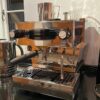
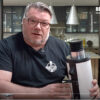
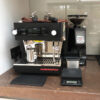

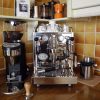
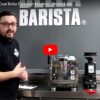
Join the discussion One Comment